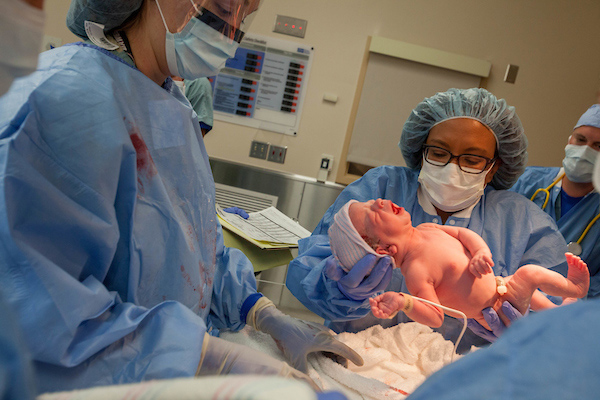The University of South Florida-led study created a rigorous mathematical model to simulate maternal and newborn outcomes, comparing elective induction to expectant management
TAMPA, Fla. (April 25, 2018) – It’s better to induce labor than to watch and wait. That’s the main result of a new study published in PLOS ONE.
Researchers at the University of South Florida Morsani College of Medicine found that first-time healthy mothers electively induced at 39 weeks of pregnancy are at lower risk of cesarean delivery and other serious complications compared to those expectantly managed and induced at 41 weeks if undelivered by then.
Obstetricians generally recommend inducing (artificially stimulating) labor and delivery after 41 weeks since continued pregnancy after this point is associated with higher chances of stillbirth and risks to the mother. However, uncertainty exists about best timing of deliveries when the fetus is between 39 and 41 weeks. The USF-led study presents compelling evidence that electively inducing labor at 39 weeks results in less risk, not more, to mothers and their newborn infants than expectant management, or watchful waiting, in the same population.
Elective induction was associated with reduced rates of cesarean deliveries and maternal complications including preeclampsia, fewer stillbirths and newborn deaths, and lower rates of newborn complications such as birth injuries, respiratory distress and shoulder dystocia (infant’s shoulder becomes lodged behind the mother’s pubic bone).
“Safely preventing primary cesarean deliveries, stillbirths and reducing other perinatal complications are of the greatest concern,” said the study’s principal investigator Charles J. Lockwood, MD, senior vice president for USF Health and dean of the Morsani College of Medicine. “Sometimes clinicians do something because that is the way it’s always been done. These findings demonstrate the importance of strong evidence-based research in informing and shaping standards of care.”
“When I was in residency training, it was drilled into us that elective induction of labor increased C-section deliveries. But, actually we found the opposite” said lead author Rachel Sinkey, MD. Dr. Sinkey conducted the research when she was a maternal-fetal medicine fellow at USF Health and is now an assistant professor of obstetrics and gynecology in the Division of Maternal-Fetal Medicine, University of Alabama at Birmingham.
The USF researchers created a rigorous mathematical model, using data from the NIH’s Safe Labor Consortium supplemented by review of the latest medical literature. A theoretical cohort of 100,000 patients was used to simulate key pregnancy outcomes for two groups: first-time mothers with low-risk pregnancies who elected to have labor induced at 39 weeks and those choosing expectant management with induction of labor only if medically indicated or if their pregnancies extended beyond 41 weeks.
Compared to elective induction of labor at 39 weeks, waiting to induce labor at 41 weeks resulted in increased:
- C-section rates (35.9 vs. 13.9 percent). Even when the cervix was unfavorable in position or dilation, C-sections were more frequent with expectant management.
- Maternal complications (21.2 vs. 16.5 percent)
- Stillbirths (0.13 vs. 0 percent)
- Newborn deaths (0.25 vs. 0.12 percent)
- Severe neonatal complications (12.1 vs. 9.4 percent)
The USF findings were recently corroborated by results of the National Institutes of Health-supported ARRIVE trial of induction versus expectant management. That large-scale, randomized controlled trial also found that induction of labor at 39 weeks in low-risk pregnant women resulted in a lower frequency of cesarean deliveries and preeclampsia.
The USF findings are supported by biologically plausible explanations. Both inadequate delivery of essential nutrients and oxygen to the fetus, known as placental insufficiency, and increasing fetal growth are associated with advanced pregnancies and may explain why elective induction of labor at 39 weeks reduces the risk of adverse pregnancy outcomes, Dr. Sinkey said.
More study is needed to address health care system logistics and costs associated with routine elective induction of labor at 39 weeks. Spontaneous labor without medical intervention remains critically important to many women, Dr. Sinkey said, however, induction of labor should be presented to patients as an acceptable option.
“We acknowledge that not all women nor their providers desire elective inductions and we recommend that the patient should be final arbiter of the timing and mode of delivery after adequate counseling and informed consent,” the study authors conclude.

